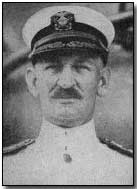Encyclopedia - The Northern Barrage
 The Northern Barrage,
chiefly laid by the U.S. Navy, formed an attempt by the Allies in mid-1918
to seal up the northern exits of the North Sea to enemy (invariably German)
U-boats. This was to be achieved by the laying of vast minefields
stretching from the Orkney Islands to the Norwegian coast.
The Northern Barrage,
chiefly laid by the U.S. Navy, formed an attempt by the Allies in mid-1918
to seal up the northern exits of the North Sea to enemy (invariably German)
U-boats. This was to be achieved by the laying of vast minefields
stretching from the Orkney Islands to the Norwegian coast.
Planning for the laying of the Northern Barrage took shape following U.S. entry into the First World War, and was largely propounded by U.S. Admiral Henry Mayo, commander of the U.S. Atlantic Fleet from June 1916 through to the end of the war; and by the British First Sea Lord Rosslyn Wemyss. In planning the Northern Barrage it was envisaged that it would usefully complement the ultimately successful - after numerous attempts - Dover Barrage.
In the event the Northern Barrage was, despite Allied propaganda to the converse, something of a failure. Planned from July 1917 and approved by the Admiralty in London the following month, inclement winter weather required that its laying be delayed until the following spring, although mines were shipped to Scotland in readiness towards the close of the year.
For a period of five months from June 1918 U.S. vessels, mainly small, laid almost 70,000 mines spanning the North Sea's northern exits. Some 80% of all mines set down were by the U.S. Navy acting chiefly alone.
Meanwhile the German Navy was well aware of the Allies' efforts in spite of unsuccessful attempts to conceal the operation. Worse still, the Barrage, once completed, proved ineffective. German U-boats continued to pierce the Allied defences and actually rose to approximately 40 per month towards the close of the war. A mere three German U-boats were trapped by the minefield.
'Push' was slang signifying a large-scale attack upon enemy positions.
- Did you know?
